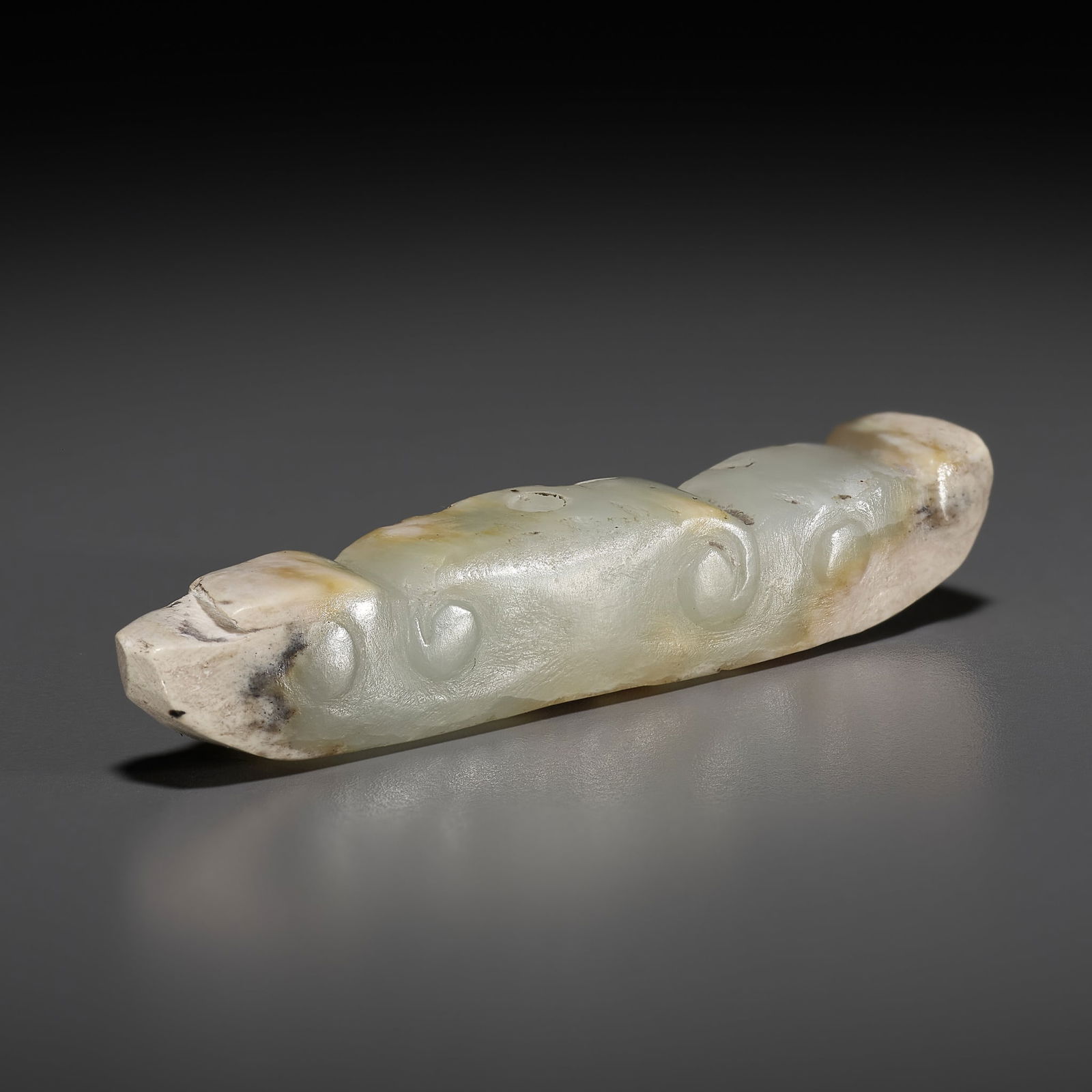
A JADE 'SILKWORM' PENDANT, LATE NEOLITHIC PERIOD TO SHANG DYNASTY
Similar Sale History
View More Items in Necklaces & Pendants





Related Necklaces & Pendants
More Items in Chinese Necklaces & Pendants
View MoreRecommended Jewelry
View More













Item Details
Description
Please note this Lot is to be sold at No Reserve. 本拍品不設底價
China, c. 1300 BC or earlier. The pendant pierced vertically and carved in the form of a silkworm, incised at one end with its head, detailed with large rounded eyes and slightly open mouth, the body with stylized 'comma-scrolls'. The translucent stone is of a pale celadon tone with few dark inclusions and patches of opaque creamy-white calcification.
Provenance: Collection of Harry Geoffrey Beasley (1881-1939) and thence by descent to his widow Irene Beasley. Collection of Alfred William Cowperthwaite (1890-1964), acquired from the above c. 1939 and thence by descent in the same family. Harry Geoffrey Beasley (1881-1939) was a British anthropologist and museum curator who developed an important ethnographic collection during the early 20th century that is now held in various British museums. With his wife Irene, Beasley set up the Cranmore Ethnographical Museum which eventually held more than 6,000 objects of ethnographical interest. The Beasleys collected objects from across Europe, buying from auction houses and local museums to expand the collection, which contained material from the Pacific, Asia, Africa, and Northwestern America. Beasley wrote numerous articles for anthropological journals and was considered an expert in his field. He died in 1939 and his collection was stored with the British Museum collections during the war, which was fortunate, as the Cranmore Museum was destroyed by bombing. After the war, substantial portions of the collection were passed to the British Museum, the Royal Museum in Edinburgh, the Museum of Archaeology and Anthropology, the University of Cambridge, the Pitt Rivers Museum, and the Merseyside County Museum. Other pieces, such as the present lot, were sold by his widow and, after her death in 1974, by their daughters. Alfred William Cowperthwaite (1890-1964) was a contributor to the Cranmore Museum and became good friends with Harry Beasley. Shortly after Harry Beasley's death, he acquired a number of objects from Irene Beasley, including the present lot.
Condition: Good condition, commensurate with age. Wear, minor nibbling, small chips, some of which have smoothened over time, signs of weathering and erosion. The stone with natural fissures, some of which have developed into small hairline cracks over time.
Weight: 5.4 g
Dimensions: Length 4.5 cm
Literature comparison:
Compare a related jade pendant in the shape of a silkworm, dated ca. 10th century BC, 4.8 cm long, in the Metropolitan Museum of Art, accession number 2006.398. Compare a related jade ornament in the form of a silkworm, 7.8 cm long, in the Harvard Art Museums, object number 1943.50.314.
Auction result comparison:
Type: Related
Auction: Christie's Hong Kong, 29 November 2017, lot 2702
Price: HKD 1,375,000 or approx. EUR 182,000 converted and adjusted for inflation at the time of writing
Description: A pair of jade silkworm-form pendants, late Hongshan culture, circa 3500-3000 BC
Expert remark: This pair of jade silkworm pendants is likely earlier and a prototype for the present lot, which is more stylized with its 'comma-scroll' decoration. Note that this lot comprises a pair. Note the size (4.4 cm).
新石器時代末期至商代玉蠶佩飾
中國,約公元前 1300年或更早。吊墜垂直穿孔,雕刻成蠶的形狀,一端蠶頭有圓圓的大眼睛和微張的嘴巴,身體上刻有勾雲紋。玉料呈淺青色,半透明,輕微深色內沁和不透明的白色鈣化斑塊。
來源:Harry Geoffrey Beasley (1881-1939)收藏,他逝世後由其遺孀Irene Beasley保存;Alfred William Cowperthwaite (1890-1964),約於1939年購於上述收藏,之後在同一家族保存至今。Harry Geoffrey Beasley (1881-1939) 是一位英國人類學家和博物館館長,他在二十世紀初建立了一個重要的民族志收藏,現在收藏在英國的各個博物館中。Beasley和他的妻子Irene一起建立了Cranmore民族志博物館,該博物館最終收藏了 6,000 多件民族志方面的物品。Beasley 收集了來自歐洲各地的物品,從拍賣行和當地博物館購買以擴大收藏範圍,其中包含來自太平洋、亞洲、非洲和美國西北部的資料。Beasley為人類學期刊撰寫了大量文章,被公認爲是該領域的專家。他於 1939 年去世,他的藏品幸虧在戰爭期間被存放在大英博物館裏,而Cranmore博物館被轟炸摧毀。戰後,大部分藏品被轉移到大英博物館、愛丁堡皇家博物館、劍橋大學考古與人類學博物館、Pitt Rivers博物館和Merseyside County博物館。其他收藏,例如現在的拍品,由他的遺孀出售,在她 1974 年去世後,由他們的女兒出售。Alfred William Cowperthwaite (1890-1964) 曾是Cranmore 民族志博物館重要支持人,也曾是 Harry Beasley的好友。在Harry Beasley去世不久,他從Irene Beasley 處購買了一些收藏,包括此件拍品。
品相:條件好,與年齡相稱。磨損、輕微的嗑損、小碎片,其中一些隨著時間的推移已經變得光滑,有風化和侵蝕的跡象。具有天然裂隙的石頭,隨著時間的推移,其中一些已經發展成細小的髮絲狀裂紋。
重量:5.4 克
尺寸:長 4.5 厘米
文獻比較:
比較一件相近的約公元十世紀玉蠶佩飾,長4.8 厘米,收藏於大都會藝術博物館,收藏編號2006.398。比較一件相近的玉蠶佩飾,長7.8 厘米,收藏於哈佛藝術博物館,館藏編號 1943.50.314。
拍賣結果比較:
形制:相近
拍賣:香港佳士得,2017年11月29日,lot 2702
價格:HKD 1,375,000(相當於今日EUR 182,000)
描述:約公元前3500-3000 年紅山文化晚期玉蠶
專家評論:這對玉蠶吊墜年代較早,也是本拍品的較早的原型,其“逗號捲軸"紋飾更具風格化。請注意此為一對和尺寸(4.4厘米)。
Buyer's Premium
- 30%
A JADE 'SILKWORM' PENDANT, LATE NEOLITHIC PERIOD TO SHANG DYNASTY
Shipping & Pickup Options
Item located in Vienna, Vienna, atPayment































































![Lock of Robert E. Lee's Hair & Archive: LARGE LOCK OF ROBERT E. LEE'S HAIR FROM HIS LEXINGTON, VIRGINIA DOCTOR, HOWARD T. BARTON. Large lock of General Robert E. Lee's hair, taken at death. [Lexington, Virginia], [1870]. Approx. length 6 in](https://p1.liveauctioneers.com/7226/325455/175169168_1_x.jpg?height=310&quality=70&version=1712370394)










